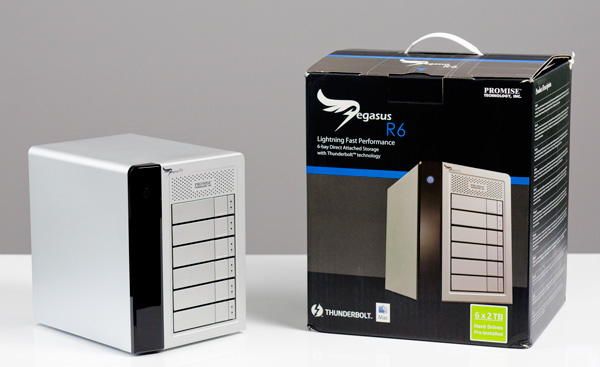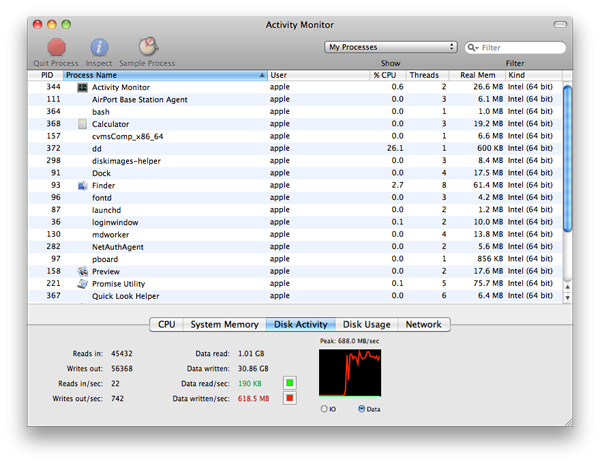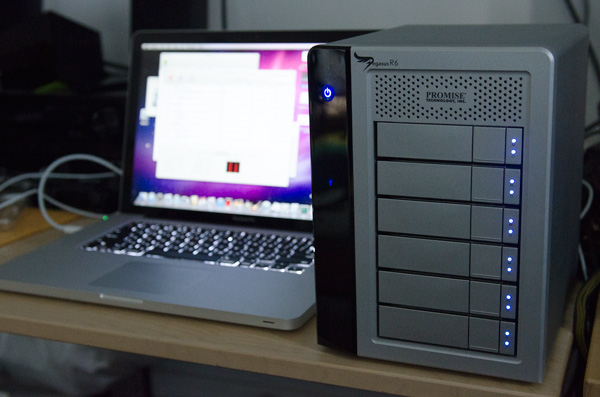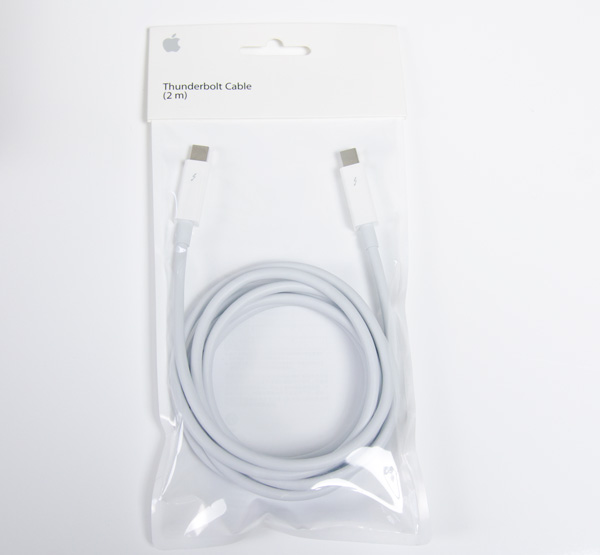Apple Thunderbolt Cable & Promise Pegasus RAID System Available Now
by Anand Lal Shimpi on June 28, 2011 10:16 AM EST- Posted in
- Mac
- Apple
- Thunderbolt
- Promise
- Pegasus
This morning Apple finally announced availability of its first Thunderbolt cable alongside Promise's Pegasus external RAID solution. We've previewed the Pegasus in the past but today we received a shipping model of the 6-bay 12TB.
The packaging isn't quite as nice as what we're used to from Apple, but the device inside is really what matters. The R6 comes with six removable drive bays capable of accepting both 2.5" and 3.5" drives.

There are two LEDs per drive bay as well as power and Thunderbolt LEDs on the left side of the device:
The Pegasus is audible thanks to its six hard drives and two fans, but it's not what I'd consider loud.
Promise is announcing availability of four different configurations of the Pegasus available via Apple's online store:
| Promise Pegasus Lineup | ||||||
| # of Bays | Drive Configuration | Default Capacity | Price | |||
| Promise Pegasus R4 4TB | 4 | 4 x 1TB RAID-5 | 2.7TB | $999 | ||
| Promise Pegasus R4 8TB | 4 | 4 x 2TB RAID-5 | 5.7TB | $1499 | ||
| Promise Pegasus R6 6TB | 6 | 6 x 1TB RAID-5 | 4.7TB | $1499 | ||
| Promise Pegasus R6 12TB | 6 | 6 x 2TB RAID-5 | 9.7TB | $1999 | ||
All of the available Pegasus systems ship with 7200RPM 3.5" hard drives, although Promise mentioned that we will may see SSD enabled configurations in the future. The 12TB R6 we received uses six Hitachi Deskstar 7K3000 2TB drives (HDS723020BLA642) in a 9.7TB RAID-5 configuration. The 7K3000 spins its four platters at 7200RPM and buffers data with a 64MB on-board cache. The drive has a 6Gbps SATA interface although the Pegasus R4/R6 supports SAS drives as well. All of the Pegasus devices ship in RAID 5 however they do support RAID-0/1/5/50/6/10.

I had no problems creating data on the Pegasus array at up to 688MB/s
The 2 meter Thunderbolt cable is also finally available at $49.99. The cable is compatible with all 2011 MacBook Pros as well as the 2011 iMac.
We'll be testing the Pegasus R6 over the coming days, stay tuned for our review!
























47 Comments
View All Comments
Steveymoo - Wednesday, June 29, 2011 - link
I like the way your third sentence of the article mentions the fact that the packaging "isn't quite as nice as what we're used to from Apple."I mean.... Really??? This is meant to be a RAID device for professional editors/artists. I know you're an Apple user, but.... just............. wtf.
Landiepete - Thursday, June 30, 2011 - link
Please extract your thumb trom your rectal tract.The guy was looking for a way into the article, and used the packaging as a stepladder.
It may be inconsequential to the raw facts, but it's a reviewers take on a product. If you don't like it download datatsheets.
usb4ftw - Friday, July 1, 2011 - link
I really like the idea of a universal bus for every external device from a monitor to a drive to a memory stick to whatever...not a fan of closed standards though
is the maximum speed on this pegasus drive a thunderbolt bottleneck or a drive bottleneck, thats what id like to know
i'm guesssing its going to be the drive
blacknight582 - Wednesday, July 20, 2011 - link
drive speed actually isn't even the issue at these speeds... the real issue is latency and drive alignment.Don't know how much you know about it but I'll make it super easy,
When drives are spinning at 7200 rpm, the data physically on the disk you are reading from could be on the opposite side of the physical hard disk as it is spinning, so you have to wait for the disk to get around to where the read/write head is on the hard drive to pull the information from the disk.
This is known commonly as Latency :)
Wikipedia has a good equation/example for this.. scroll down to "RAID 5 Latency"
http://en.wikipedia.org/wiki/Standard_RAID_levels
although this specifies RAID 5 as being the only RAID level with problems, do realize that others also share this issue. Some RAID levels arrange the drives/align the drives when they spin up so they will stripe accordingly and in sync, but unless you are spending $20K+ you're probably not seeing that kind of quality in any RAID application... especially not at the home consumer level.
At these speeds, drive latency is going to be the biggest issue.
centaur1 - Monday, July 4, 2011 - link
Ok, these things come with 2TB drives. Any idea if the 3TBs will work in them?:-)
xMoe - Friday, August 12, 2011 - link
There is no "Apple tax" and the "closed" technology/standard here is just as closed as say - PCIexpress, USB2, SATA and Firewire - ALSO developed by Intel -iirc.This is very new prosumer tech. Just because this tech does not currently (or may never) fit your needs/wants/desires - it does not follow that there is no market for this. Also keep in mind this is a possible way to "future proof" your system ... at least as future proof as you can get. Want two or three extra high res monitors for your laptop? No problem - this port has the bandwidth... want to add USB3 to your current TB laptop? no problem (in theory) ... now you dont need those expensive Magma chassis to put in extra cards for USB, video, networking, etc....
The few of you attempting to figure the cost are way off... unless I missed something there are a couple factors here:
1) how much is your data worth? ... if you just have a few crappy movies - maybe not much, but maybe you are running a business or two off this type of tech? The consideration is not getting this for home use (necessarily), but how reliable, how big and fast this device is.
2) how much is the raid controller and software worth? What happens when a drive dies, how fast/reliable is the rebuild? What are the odds the controllers dies or the the power supply on the box dies? Will the RAID card corrupt your data? What's the SLA for your replacement parts?
3) also pricing may come down - eventually.
RAID 5 is nice - for REDUNDANCY - not necessarily speed. A RAID 0 SSD setup will get you more speed, but if one drive goes sideways - you project is well... gone.
You ever see the size of a mail store for even a small (50 person) company?
You connect your RAID to your Mac Mini and YOUR backup as well (you can make a bootable via scripts) and their's some oK redundancy there.
So yeah, you do not need 10GigE ... his is more for HD video and other large (heavy) data sets, though it is ironic how Apple is doing its best to kill off all their Pro apps, hardware, etc...
So you can have several NASs .... and one or two VM servers ... or you can have several servers - each with their own direct attached storage.
Yes you can get CHEAPER and you can probably get 85% of the performance of this setup... but you can also crash and burn.
I do believe the one post where Apple can get rid of the Pro Towers for the Mini's and the Mac Books (and might keep the MBPro)...
percykwong - Tuesday, January 31, 2012 - link
I figured it out and posted the solution.swimminginthought.com
Hope it makes some of you happy.